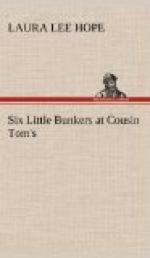“But I was scared till you grabbed hold of me,” she said to Mun Bun. “Is it very deep any more?”
“No, it isn’t deep at all,” the little boy answered. “I can see down to the bottom all the way to the little island, and it isn’t hardly over your toenails.”
The tide was very low that day, and in some parts of the inlet there was no water at all, the sandy bottom showing quite dry in the sun.
As Cousin Tom had said, toward the fall of the year the tides are both extra high and extra low. Of course not at the same time, you understand, but twice a day. Sometimes the waters of the ocean came up into the inlet until they nearly flowed over the small pier. Then, some hours later, they would be very low. This was one of the low times for the tide, and it had made several small islands of sand in the middle of Clam River.
It was toward one of these islands that Margy and Mun Bun were wading. They had seen it from the shore and it looked to be a good place to play. There was a big, almost round, spot of white sand, and all about it was shallow water, sparkling in the sun. The deepest water between the shore and the island was half way up to Margy’s knees, and that, as I think you will admit, was not deep at all.
“We’ll have some fun there,” said Mun Bun.
“Maybe we can dig clams,” went on the little girl.
Clam River was so called because so many soft and hard clams were dug there by the fishermen, who sold them to people who liked to make chowder of them.
There are two kinds of clams that are good to eat, the hard and the soft. One has a very hard shell, and this is the kind of clam you most often see in the stores.
But there is another sort of clam, with a thin shell, and out of one end of it the clam sticks a long thing, like a rubber tube. And when the clam digs a hole for himself down in the sand or the mud he thrusts this tube up to the top, and through it he sucks down things to eat.
The six little Bunkers had often seen the fishermen on Clam River dig down after these soft-shelled fellows. The men used a short-handled hoe, and when they had dug away the sand there they found the clams in something that looked like little pockets, or burrows.
“Maybe we can dig clams,” said Margy.
“We hasn’t got any shovel or hoe,” returned Mun Bun.
“Maybe we can dig with some big clam shells, if we can find some,” his sister said.
By this time they had reached the little island. Just like the islands in your geography, it was “entirely surrounded by water,” and it made a nice place to play, except that it was rather sunny. But Mun Bun and Margy did not mind the sun very much.
They were used to playing out in it, and they were now as brown as berries, or Indians, or nuts, whichever you like best. They were well tanned, and did not get sunburned as many little boys and girls do when they go to the seashore for the first time.




